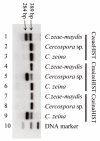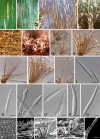Species of Cercospora associated with grey leaf spot of maize
- PMID: 18490979
- PMCID: PMC2104713
- DOI: 10.3114/sim.55.1.189
Species of Cercospora associated with grey leaf spot of maize
Abstract
Grey leaf spot is a serious yield-reducing disease of maize (Zea mays) in many parts of the world where this crop is cultivated. The causal organism associated with the disease is Cercospora zeae-maydis. Two potential sibling species have been recognized as Groups I and II. The DNA sequences for the internal transcribed spacers (ITS1 & ITS2), the 5.8S rRNA gene, elongation factor 1-alpha, histone H3, actin and calmodulin gene regions suggest that Groups I and II are two distinct species. Furthermore, Cercospora zeae-maydis (Group I) can be distinguished from C. zeina sp. nov. (Group II) by its faster growth rate on artificial media, the ability to produce cercosporin, longer conidiophores, and broadly fusiform conidia. A PCR-based test that distinguishes the two species was developed using species-specific primers designed from the histone H3 gene.
Figures





References
-
- Carbone I, Kohn LM (1999). A method for designing primer sets for speciation studies in filamentous ascomycetes. Mycologia 91: 553–556.
-
- Chupp, C. (1954). A monograph of the fungus genus Cercospora. Ithaca, New York. Published by the author.
-
- Corlett M (1991). An annotated list of the published names in Mycosphaerella and Sphaerella. Mycologia Memoir 18, 1–328.
-
- Crous PW (1998). Mycosphaerella spp. and their anamorphs associated with leaf spot diseases of Eucalyptus. Mycologia Memoir 21: 1–170.
-
- Crous PW, Braun U (2003). Mycosphaerella and its anamorphs. 1. Names published in Cercospora and Passalora. CBS Biodiversity Series 1: 1–571.
LinkOut - more resources
Full Text Sources
